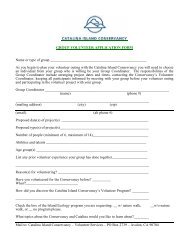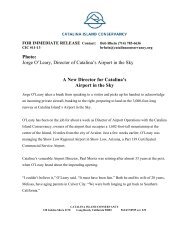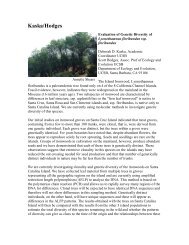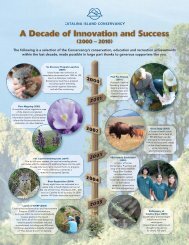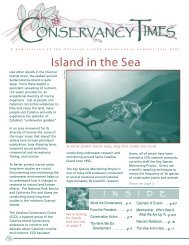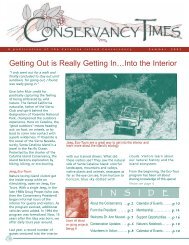Internship Program Policy External - Catalina Island Conservancy
Internship Program Policy External - Catalina Island Conservancy
Internship Program Policy External - Catalina Island Conservancy
Create successful ePaper yourself
Turn your PDF publications into a flip-book with our unique Google optimized e-Paper software.
outdoor cooking facilities and a children’s playground. The <strong>Conservancy</strong> is committed torestoring this community resource to its former beauty and improving it for all to enjoy.FAMILIES IN NATURE PROGRAMFamilies In Nature is an outreach initiative designed to enable <strong>Catalina</strong> resident families to gainaccess to nature based activities, and to have what can be life-changing interpretive experiencesat no cost to them.The <strong>Conservancy</strong> believes that the enjoyment of the interior by ALL residents is important forthe well-being of the community and the <strong>Island</strong>’s future. Support of this program will helpcreate a well-informed community who understands and benefits from its native and rare naturalsurroundings, and who will want to protect and restore <strong>Catalina</strong> for generations to come.NATIVE PLANT NURSERYThe flora of <strong>Catalina</strong> <strong>Island</strong> is part of what makes it such a special place. In the late 1980s, the<strong>Catalina</strong> <strong>Island</strong> <strong>Conservancy</strong> established a native plant nursery at Middle Ranch in the <strong>Island</strong>’sinterior. The nursery’s mission is to provide plant and seed material for restoring native habitatson the <strong>Island</strong>. (The nursery was named in memory of Mr. James H. Ackerman, a <strong>Conservancy</strong>Benefactor who also served on the Board of Directors).At the Nursery, plants are grown from seed or from cuttings collected from specimens growingin the wild on the <strong>Island</strong>. Rare habitat plant species, and endemic or federally listed EndangeredSpecies are the primary focus at the facility.FOXESThe <strong>Catalina</strong> <strong>Island</strong> fox is found on <strong>Catalina</strong> <strong>Island</strong> and nowhere else in the world. An adult foxweighs just 4 to 6 pounds, and is about 25% smaller than its mainland ancestor the gray fox. Itsdiet includes mice, lizards, birds, berries, insects, and cactus fruit. It is <strong>Catalina</strong>'s largestterrestrial predator.In late 1999, an outbreak of distemper virus caused the fox population to plummet from about1300 to just 100 animals. In 2000, the <strong>Catalina</strong> <strong>Island</strong> <strong>Conservancy</strong> and its partner, the Institutefor Wildlife Studies, implemented the <strong>Catalina</strong> <strong>Island</strong> Fox Recovery Plan. This plan combinedrelocation, vaccinations, captive breeding and release, and wild fox population monitoring.The effort was a startling success. In 2004, <strong>Catalina</strong>’s fox population had grown toapproximately 300. Because of its success, the captive breeding portion of the program wasdiscontinued. That year, the U.S. Fish and Wildlife Service listed the <strong>Catalina</strong> <strong>Island</strong> fox as afederally “endangered” species.NATURALIST TRAINING PROGRAMThe <strong>Conservancy</strong> is committed to provide accurate, consistent and up-to-date information aboutthe <strong>Island</strong> and its many interesting and rare native plant and animal species, not only to our staffbut to all guides and naturalists on the <strong>Island</strong>. The goal of the Naturalist Training <strong>Program</strong> is todevelop a corps of Master Guides and <strong>Conservancy</strong> educators that will expand the<strong>Conservancy</strong>’s educational outreach.Page 3 of 13<strong>Catalina</strong> <strong>Island</strong> <strong>Conservancy</strong> Intern <strong>Policy</strong>



